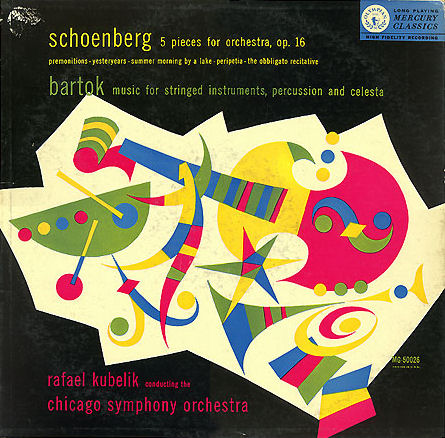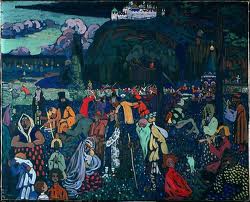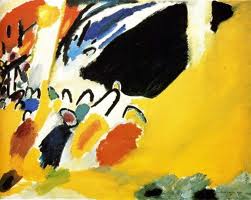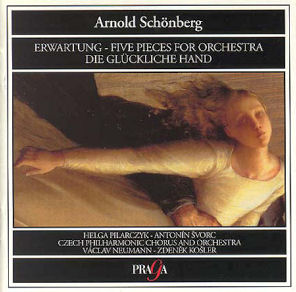Arnold Schoenberg – 5 pieces op. 16 – Kubelik


Kubelik conducts Schoenberg
| Composées vers 1909, ces pièces atonales d’Arnold Schoenberg marquent une rupture franche de langage avec son œuvre précédente, la 1e symphonie de chambre. Les 5 mouvements de l’œuvre se sont vues attribuer un titre par l’auteur, qu’il retira par la suite :
Une œuvre à la tonalité très « élargie », célèbre pour sa 3e « Farben », pièce magique, sans motif, véritable mélodie de timbres (« Klangfarbenmelodie »), supposée évoquer les couleurs ressenties auprès d’un lac, qui nécessite de faire entrer les différentes parties instrumentales sans aucune accentuation, ce qui est remarquablement fait ici par Kubelík dans cette version qui n’a jamais été surpassée.
Le parallèle entre Schoenberg et Kandinsky est bien connu : l’un passe d’un chromatisme exacerbé à l’atonalité, puis au dodécaphonisme l’autre de la figuration dans un style russe à la dilution des représentations pour aboutir à une abstraction très géométrique. (Le 2e tableau, Impression III, lui a été inspiré à la suite d’un concert Schoenberg avec notamment les 3 pièces pour piano op. 11).
Ici, la 3e pièce « Passé » : Cet enregistrement fait partie de la série que Kubelik fit durant ses années à la tête du Chicago Symphony. Son fils m’a dit un jour qu’il avait accepté de les faire un peu à contre-cœur, on ne sait pourquoi. Outre le premier disque hi-fi de l’histoire (Tableaux de Mussorgsky), il réalisa 2 enregistrements historiques : celui-ci (couplé avec un de ses tubes : les Métamorphoses symphoniques d’Hindemith) et My Vlast de Smetana, une de ses toutes meilleures versions (on en a 12…). On a comparé avec Rattle / Birmingham (EMI – 1989) et Neumann / Philharmonie tchèque (Praga – Live – 1967) : le premier est très clair, mais sans aucune expressivité, le deuxième est très intéressant, malgré les conditions du live : une véritable interprétation, de superbes sonorités, une lecture peut-être un peu trop post-romantique. À trouver d’occasion, ce disque, qui contient 2 superbes versions des op. 17 Erwartung et op. 18 Die glückliche Hand, étant épuisé chez l’éditeur. L’écoute du CD original de Mercury propose à la suite les Variations du paon de Kodaly et le Mandarin merveilleux de Bartok, dans l’interprétation superbe de Dorati. Après l’op. 16, on retrouve comme un monde perdu, plein de nostalgie avec Kodaly, puis le Bartok nous rappelle que l’invention rythmique était plutôt de ce côté, avec Stravinsky, plutôt que chez les trois Viennois… On peut trouver cet enregistrement dorénavant à bas prix chez Naxos  |
Composed around 1909, these atonal parts mark a frank rupture of language with the preceding work, the 1st Chamber symphony. Schoenberg gave them a title which he will withdraw later on:
A work with a very “widened” tonality, famous for its 3rd “Farben”, a magic piece, without any motive, true melody of tones (“Klangfarbenmelodie”), supposed to evoke the colors felt near a lake, which requires for the various instrumental parts to enter without any accent, which is remarkably made here by Kubelík in this version which has never been surpassed. The parallel between Schoenberg and Kandinsky is well-known: one goes from an exacerbated chromatism to atonality, then to the dodecaphony, while the other goes from figuration in a Russian style to the dilution of the representations and finally to a very geometrical abstraction. (The 2nd painting, Impression III, was inspired to him after a Schoenberg concert with in particular the 3 pieces for piano Op. 11). Here, the 3rd part “Last”: We have compared with Rattle / Birmingham (EMI – 1989) and Neumann / Philharmonie tchèque (Praga – Live – 1967); the 1rst is very clear but inexpressive ; the 2nd, live, shows a real interpretation, superb sonorities, just a little bit too much post-romantic. You can still find it used on the Web, since it is now out of stock; it includes 2 superb versions of op. 17 Erwartung and op. 18 Die glückliche Hand. The listening of the Mercury original CD proposes after that the Variations on the peacock by Kodaly and the Miracoulus Mandarin by Bartok, in the superb interpretation of Dorati. After the Op. 16, one finds sort of a lost world, full with nostalgia with Kodaly, then Bartok recalls us that the rhythmic invention was on this side, with Stravinsky, rather than with the three Viennese… You can get it at low price at Naxos. |





Il existe deux autres très remarquables versons de ces pièces : celle de Dorati, en 1961, chez Mercury Living Presence, très bien enregistrée de surcroît; et celle de Karajan dans son coffret consacrée aux oeuvres de Berg, Schoenberg et Webern, dans une toute autre approche, non moins belle.
Bonjour, il semble qu’il y a une erreur concernant le tableau de Kandinsky qui a été inspiré par la musique de Schoenberg, je retrouve pour ce tableau les références de « Impression III – concert » plutôt que « Improvisation III » . Merci pour votre article très intéressant !